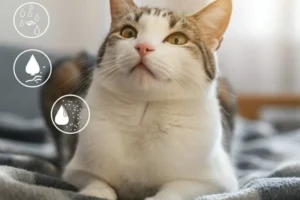
Cat Eye Infection Home Remedy: Simple Remedies for Your Friend

Finding a cat eye infection home remedy can feel overwhelming when your furry companion is clearly uncomfortable. Eye infections affect thousands of cats each year, making them one of the most common concerns for pet owners. The good news? Many minor eye infections respond well to gentle home care.
This guide will show you how to use safe and efficient remedies at home, while also helping you recognize when professional veterinary care is necessary. Remember, early intervention often leads to faster healing and prevents complications that could affect your cat’s vision or lead to a secondary infection.
Table of Contents
Understanding Cat Eye Infections
Cat eye problems stem from various sources, each requiring different approaches for effective treatment. The most common culprits include bacterial infection, viral infection, environmental allergens, physical trauma, and underlying health conditions that compromise immune function. Recognizing these different causes helps determine the most appropriate treatment.
Bacterial infection often produces thick, colored discharge and significant inflammation around the affected area. These infections often develop as secondary infections following initial injury or irritation from other environmental factors, such as dust, pollen, or chemical irritants. can trigger reactions that increase a cat’s susceptibility to bacterial overgrowth.
A viral infection called feline herpesvirus is another major source of feline eye disorders. While bacterial infections can cause red eyes, viral infections typically produce clear, watery eyes before developing into more severe symptoms. As these viral diseases of the eye are often accompanied by upper respiratory infections, a complex medical condition requiring comprehensive care is created.
Common Symptoms to Watch For
Early detection significantly improves treatment outcomes for cats experiencing eye problems. Watch for these telltale symptoms that indicate your pet needs attention:
- Persistent eye discharge ranging from clear and thin to thick and discolored
- Obvious inflammation characterized by redness, swelling, or heat around the eye area
- Frequent pawing, rubbing, or scratching at the affected eye
- Squinting, winking, or keeping one eye partially closed consistently
- Changes in eye appearance, including cloudiness or a visible third eyelid
- Behavioral changes like reduced appetite, lethargy, or avoiding bright lights
Pink eye or conjunctivitis is one of the most recognizable feline eye conditions. This condition leads to inflammation of the thin membrane that covers the eye and inner eyelid, resulting in the classic red appearance for which it is commonly known.
Safe Home Remedies for Cat Eye Infections
- Warm Compress Treatment
A gentle warm compress works wonders for reducing swelling and discomfort from minor eye infections. Soak a fresh, soft cloth in warm water (not hot). Remove any extra moisture and hold it gently against your cat’s closed eye for about 5-10 minutes.
Test the temperature on your wrist first – it should feel comfortably warm, never hot. Repeat this process 2-3 times daily, using a fresh cloth each time to prevent the spread of bacteria. This natural remedy helps soften crusty discharge and provides comfort.
- Saline Solution Rinse
Sterile saline solution helps effectively flush away debris and eye discharge. You can buy this at any pharmacy without prescription. Using clean hands, gently pull down your cat’s bottom eyelid and apply a few drops of saline. Let your cat blink naturally to distribute the solution. Never use plain water or a salt solution you’ve made at home, as it may contain harmful bacteria or have incorrect salt concentrations. Pet owners should always opt for sterile preparations for their pet’s safety.
- L-Lysine Supplements
L-Lysine shows promise for cats experiencing symptoms of feline herpesvirus. This amino acid supplement may help alleviate symptoms of viral infections and support the immune system. To determine the correct dosage, consult your veterinarian. For mature cats, the recommended dosage is typically 250–500 mg per day.
You can find L-Lysine specifically formulated for cats at pet stores or online. Mix it into wet food or use flavored versions that cats find more palatable. This approach supports overall cat health naturally.
- Gentle Eye Cleaning
Clean away crusty discharge using a soft, damp cloth to prevent eye irritation. Work from the inner corner outward, using gentle pressure. Always use separate cloths for each eye to prevent cross-contamination between eyes.
Avoid cotton balls or tissues that might leave fibers behind. Soft gauze pads or clean washcloths work best for this delicate task. Cleaning regularly helps keep away the buildup that can worsen the infection.
Professional Eye Drops and Treatment Options
While home remedies provide excellent support, some situations require professional eye drops or medication. Your veterinarian might prescribe antibiotic eye drops for bacterial infections or recommend specific treatments for cases of pink eye.
An antibiotic ointment might be necessary if the infection doesn’t respond to gentler treatments. Only a veterinary ophthalmologist or regular vet should prescribe these medications, as incorrect use can damage your cat’s vision.
Advanced Care Considerations and Professional Treatment Options
When Home Remedies Reach Their Limits
While home remedies can be effective for many minor eye infections, certain situations require immediate professional veterinary attention. Pet owners should seek expert care when these symptoms persist.
- No improvement after 2-3 days of home treatment
- Symptoms are getting worse instead of better
- Signs of pain, such as excessive pawing or vocalizing
- Changes in appetite or energy levels
- Eye trauma or obvious injury
- Thick, yellow, or green discharge
- Cloudiness in the eye itself
- Persistent watery eyes that don’t improve or complex eye conditions that general practitioners might find challenging. These specialists possess advanced training in identifying subtle changes that could indicate serious underlying conditions requiring specialized intervention.
Prescription eye drops designed specifically for cats, antibiotic ointments for treating bacterial infections, and systemic medications for addressing underlying conditions that can lead to recurrent eye issues can all be used to treat various eye ailments. These treatments tend to be more effective than home remedies for moderate to severe cases of the condition.
Understanding Treatment Timeline
Realistic expectations regarding healing timelines help pet owners make informed decisions about whether to continue home treatment or seek professional care. Minor eye infections typically show improvement within 24 to 48 hours of proper home treatment, with complete recovery occurring within 5 to 7 days.
Viral infections often require longer healing periods, which can last 10 to 14 days, even with proper care and treatment. These infections may initially worsen before improvement becomes apparent, making consistent monitoring essential for detecting complications early.
Bacterial infections usually respond more quickly to appropriate treatment but may require prescription medications for complete elimination. Secondary infection can develop when initial treatment proves inadequate, emphasizing the importance of thorough follow-through with treatment protocols.
Prevention Tips for Healthy Eyes
Keeping your cat’s environment clean significantly reduces the risk of infection. Regular vacuuming removes dust and allergens that can irritate sensitive eyes. Consider using an air purifier if your cat appears to be prone to allergies that can cause a condition that leads to sore eyes.
Stay current with vaccinations – many eye infections stem from preventable respiratory viruses. Annual vet checkups catch problems early before they become serious complications.
Minimize stress in your cat’s daily routine. Stressed cats have weakened immune systems, making them more susceptible to infections. Provide consistent feeding schedules, clean litter boxes, and quiet spaces for rest.
Special Considerations for Kittens
A kitten’s immune system is still developing, making them more vulnerable to infections than adult cats. Young cats may need gentler home remedies and closer monitoring during treatment.
If your kitten shows signs of infection, contact your vet sooner rather than later. Their smaller size means dehydration and complications can develop more quickly than in adult cats.
Natural Support for Faster Healing
Good nutrition supports your cat’s natural healing processes and overall health. Seek out vitamin A, vitamin C, and vitamin E-rich meals, which also support overall immune function.
Ensure your cat drinks plenty of fresh water daily. Proper hydration helps the body naturally flush out toxins and support the immune system’s ability to fight infections.
Creating a Comfortable Recovery Environment
Ensure your cat has a comfortable place to rest where it will not be disturbed while recovering. Dim lighting reduces strain and discomfort in sensitive eyes. Keep food, water, and litter boxes easily accessible so your cat doesn’t need to search when feeling unwell.
Watch for signs that other pets in the household might be developing similar symptoms. While not all infections are transmitted between cats, some viral infections are contagious and require careful monitoring.
Recognizing Different Types of Eye Problems
Understanding the difference between various eye conditions helps pet owners choose appropriate home remedies. Simple irritation from dust may only require gentle cleaning, while more serious infections necessitate comprehensive treatment.
Bacterial infections typically produce thick, colored discharge, whereas viral infections often initially create clear, watery discharge. Both types can benefit from the gentle home remedies described above when caught early.
Take Action for Your Cat's Eye Health
A cat eye infection home remedy can provide valuable relief for mild cases, but knowing when to escalate care is equally important. Begin with gentle warm compresses and saline rinses, while closely monitoring your cat’s symptoms.
Remember that persistent or worsening infections need professional veterinary care. Early treatment prevents complications and gets your feline friend back to their playful, comfortable self more quickly. Your cat’s vision and comfort depend on taking appropriate action at the first signs of trouble.
Watch for improvement within 2-3 days of starting treatment. Seek expert guidance and consider prescription treatment from your veterinarian if symptoms persist or intensify.



